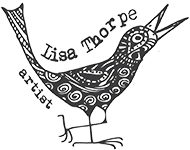Shekhinah: she who dwells within

This is the third in a series of art pieces in which I endeavor to illuminate the lost, obscured and manipulated sacred feminine from the Judeo/Christian pantheon.
To begin, I want to acknowledge that I am not a scholar of religion. What I have brought together is gleaned from reading and conversations and my own belief that expressions of the Sacred Feminine existed in the past, are available in the present and are crucial for a more inclusive future. That said, here is what I have gathered to add to my conviction.
Judaism arose at a certain moment in cultural history. For tens of thousands of years before the rise of Judaism, the Great Mother was the central figure of Divinity throughout many traditions. Images of the Great Mother deity from the fertile crescent area of the near east represent her in the presence of a sacred tree, often accompanied by a serpent. Sound familiar? In the first millennium B.C.E. the Goddess Kali arose in the Hindu tantric tradition, as mother of the universe and all living beings, the giver of life and death, the arbiter of transformation and revolution. Kali is depicted as a multi-armed woman meting out justice both violent and nurturing. In this milieu the worship of the Goddess Asherah from Canaanite pantheon was evident in the earliest stages of Judaism and was widespread in villages and sacred tree groves throughout ancient Israel. Asherah was symbolized by poles that were sunk deep into the earth, denoting the ground from which all life springs. Small figurines were planted in sacred groves, symbolizing the peoples’ prayers for fertility in their crops and families.
As Judaism evolved it moved away from depicting the divine in representable form and the worship of Asherah figures eventually were abandoned and banned as objects of idol worship. Within this context the concept of Shekhinah emerges. Shekhinah is a Hebrew word describing the manifestation of God’s presence on earth in feminine terms. Shekhinah can be translated as she who dwells within. She is the part of God that does not leave us. She is the guide for the people in exile; she is said to be in the pillar of clouds by day and the pillar of fire by night that guides the Israelites out of Egypt. She is the flame of the burning bush and the cloud on Mount Sinai that Moses beheld. She who dwells within is our inner flame, she is always there to guide us when we come seeking.
I see her in the ancient earth goddess figurines of cultures known and unknown. I see her in the Hindu goddess Kali, I see her in the Asherah figurines of early Canaanite peoples. In the Christian context I see Shekhinah in the Holy Spirit and most approachably in Mary the mother, nurturer, and caregiver. Mary is often called upon to intercede on our behalf to a less approachable, more remote, male depicted God figure. Shekhinah moves through them all.Unfortunately, over place and time, mention of the sacred feminine has been redacted, erased, and ignored from much of the Abrahamic religious readings, teachings and thought of Judaism, Christianity, and Islam. Why this was done is a complicated question that is probably about power and fear and a smallness of understanding. What I can do as an artist and a feminist who participates in Christian life, is to try push the conversation, to rethink the perceptions. To move beyond a binary choice of God being either male or female but both and more. I want my art and its explanation not to be the answer but one of thousands and millions of depictions, visions, and versions. When all the variations of experience of the vast power of the universe that is called God are discussed, depicted, honored, revered, and revealed – then, and perhaps only then – may we begin to come closer to understanding the true mystery and meaning that can heal the earth and bring creation into balance.






My Shekinah is luminous and strong. She has four arms to suggest her capacity to embrace and love beyond human knowing. In one set of arms, she nurtures and cradles the earth and us. With the other set of arms, she holds a ball of thread and needle, forever stitching back into balance the world we have damaged. Stitched in an arch of silver thread reaching from hand to hand are the words she who dwells within which is a translation from the Hebrew of the name Shekhinah.
The image on her dress is of water and lily pads invoking the dark mystery below the surface and the knowable floating right there for us to see and touch. She has a winged cloak with images of sparkling light reflecting on the rippling shallow water coursing over river stones just below the surface to hint at the extraordinary within the ordinary. She floats in a pillar of clouds at her feet and a pillar fire represented by stars of the distant cosmos above her, this is a reference to Shekhinah as the guide and guardian of the Israelites in their exodus from Egypt in the Hebrew bible. Behind her head are seven overlapping circles that create a pattern called the seed of life. From the concept of sacred geometry this pattern symbolizes the seed of creation from which all life resides, where life begins and returns. The seed of life pattern is also stitched into Shekhinah’s dress with silver threads.
She is embodied in the figure of an older woman, silver haired and radiant – full of wisdom, understanding and persistence. I have chosen the quilt as art medium for a reason. For me, the use of fabric and stitch is connected to the act of being a doer and maker. It is something I learned from my foremothers; the way that making a bedquilt, a garment or meal could be both a necessity of life and a creative expression. Here I use the quilt form, that is rooted in warmth and comfort, as the canvas for Shekhinah. She who dwells within – always there when you chose to seek her.
This summary is greatly informed by two main sources. Rabbi Leah Novick’s book On the Wing of Shekhinah: rediscovering Judaism’s Divine Feminine and the text of a lecture given by Shaoshanna Fershtman at the Mendocino Coast Jewish Women’s Retreat in 2018. Also thank you to my niece Francesca Rubinson, a grad student at Harvard Divinity School, for her scholarly insights and to my friend Sonia Beck Doss for sharing her perceptions on Shekhinah and for being my physical model. And finally, to my sister Laura Thorpe for being my hand model and my biggest fan.


Gayle
Hi Lisa—initially only the text came up and I found myself wondering what your piece looked like but when I hit the response button the beautiful images arrived. Thank you for your detailed description which gave great meaning to your exceptional quilt.
Lisa Thorpe
Thank you Gayle for taking the time to read, and receive the image –
Krista Larson Lopez
Lisa! This is awesome and very inspiring. Both the study and the art piece! When I read the article, I thought yes! I need to read more about Shekhinah. Being a preachers kid, a believer but not a churchgoer, and 68 years old. There are so many thoughts that have absorbed into my beliefs. This is very interesting! Thank you 🙏
Krista (from Napa, CA)
Lisa Thorpe
Thank You Krista, The book I mention at the end of the article is a good place to start in exploring Shekhinah deeper
Vivian Helena Aumond-Capone
lovely, with emotion
Valerie Komkov Hill
What a wonderful and enlightening work.
Lisa Thorpe
Thanks Val, I always am inspired by what you are doing and I’m glad I can share a bit of that with you
Sonia Beck
OMG, this is so beautiful and needs to live in a sacred place to be beheld by others who can experience her power and beauty. I am so moved by your work. Thank you for creating her. She indeed lives in all of us.
Lisa Thorpe
Sonia, Thank you for helping get started with Shekhinah and being my model – you inspire me, I glad I can return the favor!
Nancy Orr
I’ve been fascinated with the demise of the earth goddess and the sacred feminine since I read The Chalice and the Blade many years ago. Thank you, Lisa, for sharing your research. I believe we all yearn for that ancient goddess that humans universally held sacred for the millenia of our existence.
Your interpretation of Shekinah is striking in so many ways. I am most drawn to her face, wise and turned slight down and away. There is hope, yes, and also grief.
Thank you so much for the inspiration of your art.
All best wishes,
Nancy Orr
Lisa Thorpe
Wonderful Nancy, so nice to hear from you – I haven’t read the Chalice and the Blade – I’ll look into it. I appreciate your comments and I like what you had to say about her face hope and grief indeed
Michelle Jones
A wonderful depiction of woman as god-dess. I am inspired to re-read about this concept. Thank you!
Lisa Thorpe
Michelle, thank you for taking the time to read about Shekhinah I hope she moves you to create more interesting things
Beth Breedlove
Lisa, This is so beautiful. Thank you so much for sharing. I am blown away and deeply moved by both the blog post and the art quilt.
Lisa Thorpe
Thank you Beth – I am glad you found Shekhinah moving I look forward to how her creative spirit can move in you too
Susan Payne
Thank you Lisa for your teaching and work with the sacred feminine. I don’t think much in masculine terms–even in worship I am able to translate to Spirit, but I am happy to have a feminine body I can embrace.
Lisa Thorpe
Thank you Susan, I just think its important to not limit our representation of God be it in words or images – to use all our words and all our visual notions would barely scratch the surface…